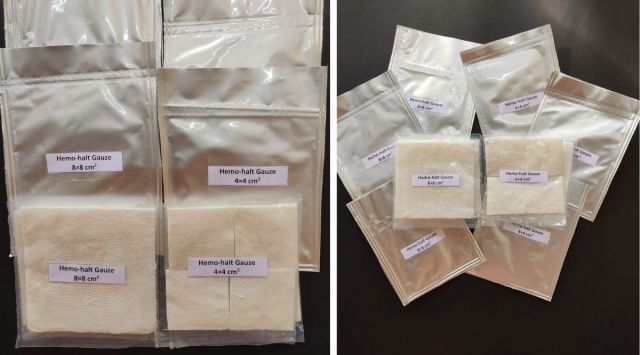Blood loss during accidents, operative procedures, and at the battleground can often be fatal. A remedy has come from a group of scientists in Pune. Heavy bleeding can be stopped in a matter of three minutes if you wrap up the wounds with the special hemostatic gauze ‘Hemohalt’ containing chitosa fabricated by the scientists at Pune’s Agharkar Research Institute (ARI). The material is absorptive, robust, and can be easily ripped off.
The scientists have prepared a biopolymer-based gel formulation and dressing in the form of ‘Hemohalt’, as an effective and safe dressing for hemorrhage control is crucial.

The material contains agonists, nanoparticles, and polymers which initiate the blood coagulation cascade and allow clotting within three minutes. This was proved in animal studies with ‘Celox’ dressing as a standard commercial agent. With ‘Hemohalt’ there was the ease of removal without disturbance of platelet plug and re-initiation of bleeding, Dr Vandana Ghormade, senior scientist from the Nanobioscience section of ARI told The Indian Express.
 Dr. Vandana Ghormade delivers a lecture at a university in Gurgaon, 2019. (Facebook/Amity University Gurugram)
Dr. Vandana Ghormade delivers a lecture at a university in Gurgaon, 2019. (Facebook/Amity University Gurugram)
Critical care guidelines recommend topical hemostatic agents in the form of pads, patches, bandages or gel applications for early control of bleeding. Gauze, a commonly used first-aid material, is inadequate in halting heavy blood loss. According to ARI scientists, there is a possibility of viral infection and tissue toxicity with conventional physical hemostatic agents like bone wax, gelatin foam, biological agents such as bovine thrombin, fibrin sealants, and synthetic agents, including cyanoacrylates and glutaraldehyde.
Considering these limitations and need for effective and safe dressing for hemorrhage control, scientists used chitosan, a natural glucosamine containing polymer that is reported to have a role in control of bleeding. Chitosan can be abundantly sourced from crustacean shells and fungal cell walls, said Dr Ghormade who coordinated the work as part of the Central Government’s Accelerated Translation Grant for Commercialization by the Department of Biotechnology.
Good laboratory practice (GLP) studies are outsourced to a third party for the product which will help in commercialisation, the scientist told The Indian Express.
Severe loss of blood (exsanguination) is responsible for 40 per cent of trauma deaths. It triggers trauma due to shock, hypothermia, coagulopathy, tissue damage, and organ failure that often causes mortality. “Hence efforts for early hemorrhage control are important to prevent disability or death during severe blood loss. The natural defences of the human body operating through a reduction in blood flow to the injury site, platelet plug formation by fibrin activation, and activation of intrinsic and extrinsic blood clotting pathways are inadequate to halt severe hemorrhage,” she said.
Story continues below this ad
The scientist explained that the currently used hemostatic agents cannot help blood coagulation and stop blood flow. “Chitosan, due to its cationic nature and hydrogel-forming ability, leads to concentration of erythrocytes and platelets in the injury site. It has been used commercially,” she said while citing examples of chitosan preparations like Celox, a lightweight chitosan foam powder produced by bubbling, and HemCon, chitosan-coated bandages that are approved by FDA. These are being used by the US army for hemorrhage control. However, these wound dressings show variable performances due to lack of stabilization of blood clot, and mechanical strength and have a tendency for adherence to wound surface, Dr Ghormade said.
“The hemostatic gauze showed good mechanical robustness and absorption capacity. The synergistic effects of combining these materials resulted in a hemostatic gauze with a highly efficient blood clotting ability. The hemostatic gauze halted bleeding in 3 minutes in vivo with a femoral artery bleeding model in Wistar rat that was significantly better than commercial products and has the added advantage of the ease of removal from the injury site,” Dr Ghormade said.
Apart from minimising blood loss before treatment coupled with potential as a sanitary pad with superior absorption, the sterile product has a shelf life of two years.
“This is a substitute to foreign brands like –Celox, Chitoclot and others. It will also contribute to the make-in-India effort. It will reduce hospitalisation costs and save lives and limbs. As a futuristic development, hemostatic soft gels are also being developed that can be applied to soft tissues and organs,” Dr Ghormade said.



 Dr. Vandana Ghormade delivers a lecture at a university in Gurgaon, 2019. (Facebook/Amity University Gurugram)
Dr. Vandana Ghormade delivers a lecture at a university in Gurgaon, 2019. (Facebook/Amity University Gurugram)





